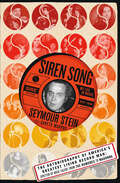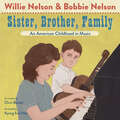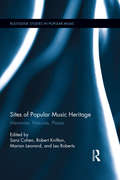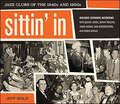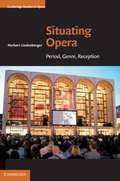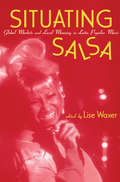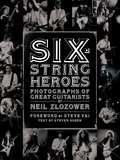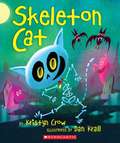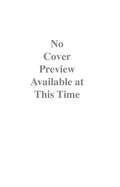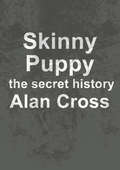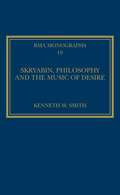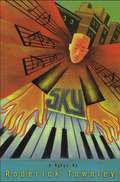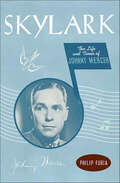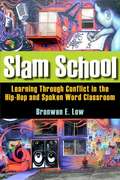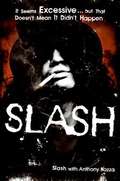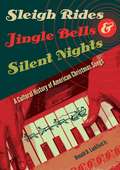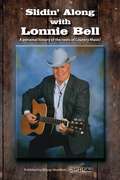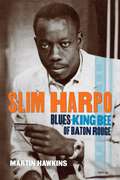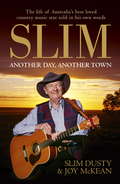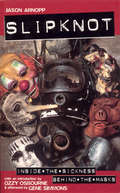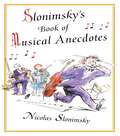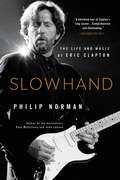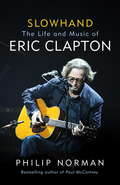- Table View
- List View
Siren Song: My Life in Music
by Seymour Stein Gareth MurphyThe autobiography of America’s greatest record man: the founder of Sire Records and spotter of rock talent from the Ramones to Madonna.Seymour Stein was America's greatest record man. Not only did he sign and nurture more important artists than anyone alive, after over sixty years in the game, he was still the hippest label head, travelling the globe in search of the next big thing. Since the late fifties, he had been wherever was happening: Billboard, Tin Pan Alley, The British Invasion, CBGB, Studio 54, Danceteria, the Rock n Roll Hall of Fame, the CD crash. Along that winding path, he discovered and broke out a skyline full of stars: Madonna, The Ramones, Talking Heads, Depeche Mode, Madonna, The Smiths, The Cure, Ice-T, Lou Reed, Seal, and many others.Brimming with hilarious scenes and character portraits, Siren Song’s wider narrative is about modernity in motion, and the slow acceptance of diversity in America – thanks largely to daring pop music. Including both the high and low points in his life, Siren Song touches on everything from his discovery of Madonna to his wife Linda Stein's violent death.Ask anyone in the music business, Seymour Stein was a legend. Sung from the heart, Siren Song will etch his story in stone.
Sister, Brother, Family: An American Childhood in Music
by Chris Barton Willie Nelson Bobbie NelsonThe first ever children's book by music legend Willie Nelson and his sister and bandmate Bobbie Nelson! "We had so little money, but so much love." He was a boy with a guitar. She was a girl with a piano. Raised by loving grandparents in Depression-era rural Texas, their humble beginnings playing local shows to put food on the table started Willie and Bobbie Nelson on a remarkable path to global stardom. In a story filled with details of a childhood in rural Texas—with church socials, general stores, and town dances—Willie and Bobbie weave together an inspiring story of a long-ago time. With triumphs and tragedies, hard work and determination, here is a deeply personal, gorgeously-written, and profoundly moving tale of hope.
Sites of Popular Music Heritage: Memories, Histories, Places (Routledge Studies in Popular Music)
by Les Roberts Sara Cohen Robert Knifton Marion LeonardThis volume examines the location of memories and histories of popular music and its multiple pasts, exploring the different ‘places’ in which popular music can be situated, including the local physical site, the museum storeroom and exhibition space, and the digitized archive and display space made possible by the internet. Contributors from a broad range of disciplines such as archive studies, popular music studies, media and cultural studies, leisure and tourism, sociology, museum studies, communication studies, cultural geography, and social anthropology visit the specialized locus of popular music histories and heritage, offering diverse set of approaches. Popular music studies has increasingly engaged with popular music histories, exploring memory processes and considering identity, collective and cultural memory, and notions of popular culture’s heritage values, yet few accounts have spatially located such trends to focus on the spaces and places where we encounter and engender our relationship with popular music’s history and legacies. This book offers a timely re-evaluation of such sites, reinserting them into the narratives of popular music and offering new perspectives on their function and significance within the production of popular music heritage. Bringing together recent research based on extensive fieldwork from scholars of popular music studies, cultural sociology, and museum studies, alongside the new insights of practice-based considerations of current practitioners within the field of popular music heritage, this is the first collection to address the interdisciplinary interest in situating popular music histories, heritages, and pasts. The book will therefore appeal to a wide and growing academic readership focused on issues of heritage, cultural memory, and popular music, and provide a timely intervention in a field of study that is engaging scholars from across a broad spectrum of disciplinary backgrounds and theoretical perspectives.
Sittin' In: Jazz Clubs of the 1940s and 1950s
by Jeff GoldA visual history of America’s jazz nightclubs of the 1940s and 1950s, featuring exclusive interviews and over 200 souvenir photos.In the two decades before the Civil Rights movement, jazz nightclubs were among the first places that opened their doors to both Black and white performers and club goers in Jim Crow America. In this extraordinary collection, Grammy Award-winning record executive and music historian Jeff Gold looks back at this explosive moment in the history of Jazz and American culture, and the spaces at the center of artistic and social change. Sittin’ In is a visual history of jazz clubs during these crucial decades when some of the greatest names in in the genre—Billie Holiday, Charlie Parker, Ella Fitzgerald, Dizzy Gillespie, Miles Davis, Louis Armstrong, Oscar Peterson, and many others—were headlining acts across the country. In many of the clubs, Black and white musicians played together and more significantly, people of all races gathered together to enjoy an evening’s entertainment. House photographers roamed the floor and for a dollar, took picture of patrons that were developed on site and could be taken home in a keepsake folder with the club’s name and logo.Sittin’ In tells the story of the most popular club in these cities through striking images, first-hand anecdotes, true tales about the musicians who performed their unforgettable shows, notes on important music recorded live there, and more. All of this is supplemented by colorful club memorabilia, including posters, handbills, menus, branded matchbooks, and more. Inside you’ll also find exclusive, in-depth interviews conducted specifically for this book with the legendary Quincy Jones; jazz great tenor saxophonist Sonny Rollins; Pulitzer Prize-winning fashion critic Robin Givhan; jazz musician and creative director of the Kennedy Center, Jason Moran; and jazz critic Dan Morgenstern.Gold surveys America’s jazz scene and its intersection with racism during segregation, focusing on three crucial regions: the East Coast (New York, Atlantic City, Boston, Washington, D.C.); the Midwest (Chicago, Cleveland, Detroit, St. Louis, Kansas City); and the West Coast (Los Angeles, San Francisco). This collection of ephemeral snapshots tells the story of an era that helped transform American life, beginning the move from traditional Dixieland jazz to bebop, from conservatism to the push for personal freedom.
Situating Opera: Period, Genre, Reception
by Herbert LindenbergerSetting opera within a variety of contexts - social, aesthetic, historical - Lindenberger illuminates a form that has persisted in recognizable shape for over four centuries. The study examines the social entanglements of opera, for example the relation of Mozart's Abduction from the Seraglio and Verdi's Il trovatore to its initial and later audiences. It shows how modernist opera rethought the nature of theatricality and often challenged its viewers by means of both musical and theatrical shock effects. Using recent experiments in neuroscience, the book demonstrates how different operatic forms developed at different periods to create new ways of exciting a public. Lindenberger considers selected moments of operatic history from Monteverdi's Orfeo to the present to study how the form has communicated with its diverse audiences. Of interest to scholars and operagoers alike, this book advocates and exemplifies opera studies as an active, emerging area of interdisciplinary study.
Situating Salsa: Global Markets and Local Meanings in Latin Popular Music (Perspectives In Global Pop Ser.)
by Lise WaxerSituating Salsa offers the first comprehensive consideration of salsa music and its social impact, in its multiple transnational contexts.
Six Sonatas for Two Persons at One Keyboard: Franz Seydelmann (Music Archive Publications)
by Bernard Bernard BrauchliFirst Published in 1997. Seydelmann's four-hand sonatas are delightful pieces of music, written for the intimate pleasure of both performers. The two parts are consistently of equal technical difficulty and interest, the balance of the dialogue being carefully maintained throughout. They are extremely varied and well-written, with most pleasing melodies. William S. Newman, agreeing with Richard Englander, rightly considered them "among the best examples of this genre from the 18th century."
Six-String Heroes
by Neil Zlozower Steven Rosen Steve VaiIn a career spanning more than 40 years, legendary rock photographer Neil Zlozower has documented an amazing who's-who of the most influential and dynamic guitarists from the late 1960s to today. Six-String Heroes collects live, candid, and studio shots of 150 of the greatest guitar players in rock, metal, punk, blues, and beyond, including Eric Clapton, Jeff Beck, Ritchie Blackmore, Slash, Jimmy Page, Keith Richards, Zakk Wylde, Dimebag Darrell, Tom Morello, Carlos Santana, Les Paul, John Lee Hooker, Chuck Berry, Pat Metheny, Al Di Meola, Joe Satriani, Yngwie Malmsteen, Edward Van Halen, Angus Young, and many more. Also featuring a foreword by Steve Vai, and including text from unpublished interviews with the guitarists throughout by music journalist Steven Rosen, Six-String Heroes is a celebration of the music, the players, and the instrument.
Skeleton Cat
by Kristyn CrowA spooky Halloween read-aloud guaranteed to tickle the smallest funny bones! After nine lives, Skeleton Cat is back for his tenth. And he has big dreams: to be a drummer. So he rattles and shakes his way through town to find the perfect band.
Skeleton Key
by David Shenk Steve SilbermanNOW AN EBOOK FOR THE FIRST TIMEFor fifty years and more than two thousand shows, the Grateful Dead have been earning the "deadication" of more than a million fans. Along the way, Deadheads have built an original and authentic American subculture, with vivid jargon and rich love, and its own legends, myths, and spirituality.Skeleton Key: A Dictionary for Deadheads is the first map of what Jerry Garcia calls "the Grateful Dead outback," as seen through the eyes of the faithful, friends, and family, including Bill Walton, Elvis Costello, Tipper Gore, Al Franken, Bob Bralove, Dick Latvala, Blair Jackson, David Gans, Bruce Hornsby, Rob Wasserman, and Robert Hunter. Skeleton Key puts you on the Merry Pranksters' bus behind the real Cowboy Neal, uncovers the origins of Cherry Garcia, follows the dancing bear on its trip from psychedelic artifact to trademarked icon, and unlocks the Dead's own tape vault.Informative reading for the new fan or the most grizzled "tourhead," Skeleton Key shines throughout with Deadheads' own stories, wit, insiders' knowledge, sincere appreciation of the music of the "band beyond description," and the diverse and soulful culture it inspires.
Skinny Puppy: The Secret History (The\secret History Of Rock Ser.)
by Alan CrossAlan Cross is the preeminent chronicler of popular music.Here he provides a history of cEvin Key, Nivek Ogre, and Skinny Puppy."Digging It, Industrially" is adapted from the audiobook of the same name.
Skryabin, Philosophy and the Music of Desire (Royal Musical Association Monographs #19)
by Kenneth M. SmithCommentary on Skryabin has struggled to situate an understanding of the composer's music within his idiosyncratic philosophical world views. Early commentators' efforts to do so failed to establish a thorough or systematic approach. And later twentieth-century studies turned away from the composer's ideology, focusing instead on 'the music itself' with an analytic approach that scrutinized Skryabin's harmonic language in isolation from his philosophy. This groundbreaking study revisits the questions surrounding the composer's music within his own philosophy, but draws on new methodological tools, casting Skryabin's music in the light not only of his own philosophy of desire, but of more refined semiotic-psychoanalytical theory and modern techniques of music analysis. An interdisciplinary methodology corrects the narrow focus of Skryabin scholarship of the last century, offering insights from New Musicology and recent music theory that lead to hermeneutical, critically informed readings of selected works.
Sky
by Roderick TownleyAlec Schuyler has two immediate problems: what to do with the rest of his life, and what to do about Suze Matheson. She's his date for the Winter Dance. And she's got trouble of her own. The English teacher, Mr. "Call me Mark" Truscott, has made a move on her, a move which Sky has witnessed from his hiding place in a coat closet. Fifteen-year-old Sky is not one for making scenes -- or even speaking up. Instead he speaks through his music, his jazz piano. This novel, in three sets and an encore, plays all the chords and paradiddles of Sky's life -- at the moment, the life of a runaway in New York City, 1959. So how come he's hiding in a tenth-grade homeroom coat closet?Since his mother died, Sky and his father have had their umpteenth fight about the future. Like many a kid, Sky must leave home to get home. For him it's the world of Beat poetry and cool jazz. Along the way, he discovers an unexpected guide -- a blind musician who shows Sky how to see -- and learns what he has to lose to gain his own voice.
Skylark: The Life and Times of Johnny Mercer
by Philip FuriaSkylark is the story of the tormented but glorious life and career of Johnny Mercer, and the first biography of this enormously popular and influential lyricist. Raised in Savannah, Mercer brought a quintessentially southern style to both his life in New York and to his lyrics, which often evoked the landscapes and mood of his youth ("Moon River", "In the Cool, Cool, Cool of the Evening"). Mercer also absorbed the music of southern blacks--the lullabies his nurse sang to him as a baby and the spirituals that poured out of Savannah's churches-and that cool smooth lyrical style informed some of his greatest songs, such as "That Old Black Magic".Part of a golden guild whose members included Cole Porter and Irving Berlin, Mercer took Hollywood by storm in the midst of the Great Depression. Putting words to some of the most famous tunes of the time, he wrote one hit after another, from "You Must Have Been a Beautiful Baby" to "Jeepers Creepers" and "Hooray for Hollywood." But it was also in Hollywood that Mercer's dark underside emerged. Sober, he was a kind, generous and at times even noble southern gentleman; when he drank, Mercer tore into friends and strangers alike with vicious abuse. Mercer's wife Ginger, whom he'd bested Bing Crosby to win, suffered the cruelest attacks; Mercer would even improvise cutting lyrics about her at parties.During World War II, Mercer served as Americas's troubadour, turning out such uplifting songs as "My Shining Hour" and "Ac-cent-tchu-ate the Positive." He also helped create Capitol Records, the first major West Coast recording company, where he discovered many talented singers, including Peggy Lee and Nat King Cole. During this period, he also began an intense affair with Judy Garland, which rekindled time and again for the rest of their lives. Although they never found happiness together, Garland became Mercer's muse and inspired some of his most sensuous and heartbreaking lyrics: "Blues in the Night," "One for My Baby," and "Come Rain or Come Shine."Mercer amassed a catalog of over a thousand songs and during some years had a song in the Top Ten every week of the year--the songwriting equivalent of Joe DiMaggio's hitting streak--but was plagued by a sense of failure and bitterness over the big Broadway hit that seemed forever out of reach.Based on scores of interviews with friends, family and colleagues, and drawing extensively on Johnny Mercer's letters, papers and his unpublished autobiography, Skylark is an important book about one of the great and dramatic characters in 20th century popular music.
Slam School: Learning Through Conflict in the Hip-hop and Spoken Word Classroom
by Bronwen E. LowIn this study, Low (education, McGill U. , Canada) relates how a white teacher implemented the study of hip-hop and spoken word culture into urban high school language arts classes, which she co-taught and helped develop the curriculum for. She analyzes the dynamics of teaching and learning in these classes to argue that the reasons that teachers and administrators resist introducing hip-hop into curriculum--its complex issues of gender, violence, sexuality, materialism, race, and language--are what make it important pedagogically. She focuses on African American youth in interaction with white youth, teachers, and administrators, describing the student's exploration of poetry performance and writing and their experiences with the language of the hip-hop culture. Annotation ©2011 Book News, Inc. , Portland, OR (booknews. com)
Slash: The Autobiography
by Anthony Bozza SlashFrom one of the greatest rock guitarists of our era comes a memoir that redefines sex, drugs, and rock 'n' roll He was born in England but reared in L.A., surrounded by the leading artists of the day amidst the vibrant hotbed of music and culture that was the early seventies. Slash spent his adolescence on the streets of Hollywood, discovering drugs, drinking, rock music, and girls, all while achieving notable status as a BMX rider. But everything changed in his world the day he first held the beat-up one-string guitar his grandmother had discarded in a closet. The instrument became his voice and it triggered a lifelong passion that made everything else irrelevant. As soon as he could string chords and a solo together, Slash wanted to be in a band and sought out friends with similar interests. His closest friend, Steven Adler, proved to be a conspirator for the long haul. As hairmetal bands exploded onto the L.A. scene and topped the charts, Slash sought his niche and a band that suited his raw and gritty sensibility. He found salvation in the form of four young men of equal mind: Axl Rose, Izzy Stradlin, Steven Adler, and Duff McKagan. Together they became Guns N' Roses, one of the greatest rock 'n' roll bands of all time. Dirty, volatile, and as authentic as the streets that weaned them, they fought their way to the top with groundbreaking albums such as the iconic Appetite for Destruction and Use Your Illusion I and II. Here, for the first time ever, Slash tells the tale that has yet to be told from the inside: how the band came together, how they wrote the music that defined an era, how they survived insane, never-ending tours, how they survived themselves, and, ultimately, how it all fell apart. This is a window onto the world of the notoriously private guitarist and a seat on the roller-coaster ride that was one of history's greatest rock 'n' roll machines, always on the edge of self-destruction, even at the pinnacle of its success. This is a candid recollection and reflection of Slash's friendships past and present, from easygoing Izzy to ever-steady Duff to wild-child Steven and complicated Axl. It is also an intensely personal account of struggle and triumph: as Guns N' Roses journeyed to the top, Slash battled his demons, escaping the overwhelming reality with women, heroin, coke, crack, vodka, and whatever else came along. He survived it all: lawsuits, rehab, riots, notoriety, debauchery, and destruction, and ultimately found his creative evolution. From Slash's Snakepit to his current band, the massively successful Velvet Revolver, Slash found an even keel by sticking to his guns. Slash is everything the man, the myth, the legend, inspires: it's funny, honest, inspiring, jaw-dropping . . . and, in a word, excessive.
Sleepovers, Solos, and Sheet Music #3
by Genevieve Kote Michelle SchustermanFormer middle-school band director Michelle Schusterman continues to celebrate the high notes and low notes of middle-school band! The band is off to New Orleans for a competition as well as a bit of sightseeing. But there is all sorts of boy treble in the band this spring. Julia has her first boyfriend, so Holly will have to keep focused to help her friends through their drama AND make sure the New Orleans trip is a trip to remember.
Sleigh Rides, Jingle Bells, and Silent Nights: A Cultural History of American Christmas Songs
by Ronald D. LankfordWhen Bing Crosby’s "White Christmas" debuted in 1942, no one imagined that a holiday song would top the charts year after year. One of the best-selling singles ever released, it remains on rotation at tree lighting ceremonies across the country, in crowded shopping malls on Black Friday, and at warm diners on lonely Christmas Eve nights. Over the years, other favorites have been added to America’s annual playlist, including Elvis Presley’s "Blue Christmas," the King Cole Trio’s "The Christmas Song," Gene Autry’s "Rudolph the Red-Nosed Reindeer," Willie Nelson’s "Pretty Paper," and, of course, Elmo & Patsy’s "Grandma Got Run Over by a Reindeer."Viewing American holiday values through the filter of familiar Christmas songs, Ronald Lankford examines popular culture, consumerism, and the dynamics of the traditional American family. He surveys more than seventy-five years of songs and reveals that the “modern American Christmas” has carried a complex and sometimes contradictory set of meanings. Interpreting tunes against the backdrop of the eras in which they were first released, he identifies the repeated themes of nostalgia, commerce, holiday blues, carnival, and travesty that underscore so much beloved music. This first full-length analysis of the lyrics, images, and commercial forces inextricably linked to Yuletide music hits the heart of what many Americans think Christmas is--or should be.
Slidin' Along with Lonnie Bell: A Personal History of the Roots of Country Music!
by Harold Hollingsworth Lonnie BellThis is a book about Lonnie Bell and his deep personal relationship with Country Music. It's about a young boy who grew up in West Virginia's coal mining country during the depression years, at about the same time that Country Music started, and in the same part of the nation. In many ways, this book is a first-hand, eye-witness account of the very origins of Country Music, from a man who was right there living it at the time. Lonnie Bell's memories are truly a Reference Manual of Country Music history. In truth, Lonnie actually had several careers, starting with 20 years active duty in the Navy that included all of World War II; then as a Country Music stage entertainer, a popular daily radio personality, and a Hall of Fame Disc Jockey. Even more amazing was the fact that it wasn't until after he retired from all of these in 1985, that Lonnie started his weekly "Lonnie Bell's Classic Country" program on KGHL AM-790. Over the next 27+ years, this live Sunday morning oldies show became legend in Montana and northern Wyoming, and Lonnie himself grew to be an icon among those who love traditional Country and Western Music and its history.
Slim Harpo: Blues King Bee of Baton Rouge
by Martin Hawkins John BrovenAs Louis Armstrong forever tethered jazz to New Orleans and Clifton Chenier fixed Lafayette as home to zydeco, Slim Harpo established Baton Rouge as a base for the blues. In the only complete biography of this internationally renowned blues singer and musician, Martin Hawkins traces Harpo's rural upbringing near Louisiana's capital, his professional development fostered by the local music scene, and his national success with R&B hits like Rainin' in My Heart, Baby Scratch My Back, and I'm A King Bee, among others. Hawkins follows Harpo's global musical impact from the early 1960s to today and offers a detailed look at the nature of the independent recording business that enabled his remarkable legacy. With new research and interviews, Hawkins fills in previous biographical gaps and redresses misinformation about Harpo's life. In addition to weaving the musician's career into the lives of other Louisiana blues players--including Lightnin' Slim, Lazy Lester, and Silas Hogan--the author discusses the pioneering role of Crowley, Louisiana, record producer J. D. Miller and illustrates how Excello Records in Nashville brought national attention to Harpo's music recorded in Louisiana. This engaging narrative examines Harpo's various recording sessions and provides a detailed discography, as well as a list of blues-related records by fellow Baton Rouge artists. Slim Harpo: Blues King Bee of Baton Rouge will stand as the ultimate resource on the musician's life and the rich history of Baton Rouge's blues heritage.
Slim: Another Day, Another Town
by Slim Dusty Joy Mckean"Australia's greatest country singer-songwriter Slim Dusty's own story, written with Joy McKean, his wife for 50 years - now updated.'It is the people you meet along the road of life who make the travelling easier. No wonder I loved it all.' Slim Dusty Slim Dusty was Australia's most well-loved and best-known country music performer. A legend in the bush, his famous hit 'A Pub With No Beer' made him a household name in the towns and cities too. Written by Slim Dusty and Joy McKean, Slim: Another Day, Another Town is a warm and honest view of their marriage of 50 years and their life together performing right around the country. This is the story of their love for each other, their family and their music - and their determination to bring country music to the whole of Australia. Slim died in 2003, but throughout Australia, and around the world, people are still playing his songs and passing them on to new generations of fans. In this updated edition of this classic biography, Joy McKean writes about her family's commitment to honouring his memory and their work to keep his name alive. If you love today's Australian country music, you'll love SLIM DUSTY: ANOTHER DAY, ANOTHER TOWN - because this is the story of where it started. "
Slipknot: Inside the Sickness, Behind the Masks With an Intro by Ozzy Osbourne and Afterword by Gene Simmons
by Jason Arnopp"The only plan right now is to kill everybody" Joey Jordison, drummerIgnoring every rule in the book and more besides, Slipknot are a notoriously controversial band who combine a talent for outrage with their music. Reminiscent of the outlandishness of punk, 'nu metal' has become the fastest growing area in rock, with Slipknot selling over 2 million copies of their debut album. And yet Slipknot spit, swear and risk injury night after night in their extraordinary live performances. Incredibly, their apparel of masks and boiler suits, which they refuse to remove, means that their fans still do not know what they look like. Jason Arnopp, the first British journalist to interview Slipknot face to mask, describes the transformation of the Des Moines crew into unorthodox mega stars. Featuring an introduction by the legendary Gene Simmons of Kiss, this biography will be the first published on the band either in the UK or America and will include exclusive interviews and in-depth information on the mysterious nine masked men.
Slonimsky's Book of Musical Anecdotes
by Nicholas SlonimskyScathing reviews, whimsical stories, and diverting games fill the pages of this utterly engaging kaleidoscope of skewed tales on the world of Classical music. It dishes out a marvelous feast of tales served up by a master storyteller whose reach extends around the world and to the beginnings of civilization.
Slowhand: The Life and Music of Eric Clapton
by Philip NormanFrom the bestselling author of Shout!, comes the definitive biography of Eric Clapton, a Rock legend whose life story is as remarkable as his music, which transformed the sound of a generation.For half a century Eric Clapton has been acknowledged to be one of music's greatest virtuosos, the unrivalled master of an indispensable tool, the solid-body electric guitar. His career has spanned the history of rock, and often shaped it via the seminal bands with whom he's played: the Yardbirds, John Mavall's Bluesbreakers, Cream, Blind Faith, Derek and the Dominoes. Winner of 17 Grammys, the Rock 'n' Roll Hall of Fame's only three-time inductee, he is an enduring influence on every other star soloist who ever wielded a pick. Now, with Clapton's consent and access to family members and close friends, rock music's foremost biographer returns to the heroic age of British rock and follows Clapton through his distinctive and scandalous childhood, early life of reckless rock 'n' roll excess, and twisting & turning struggle with addiction in the 60s and 70s. Readers will learn about his relationship with Pattie Boyd--wife of Clapton's own best friend George Harrison--the tragic death of his son, which inspired one of his most famous songs, "Tears in Heaven," and even the backstories of his most famed, and named, guitars. Packed with new information and critical insights, Slowhand finally reveals the complex character behind a living legend.
Slowhand: The Life and Music of Eric Clapton
by Philip NormanEric Clapton is acknowledged to be rock's greatest virtuoso, the unrivalled master of its most essential tool, the solid-body electric guitar.Clapton transfigured three of the 1960s' most iconic bands - the Yardbirds, Cream and Blind Faith - walking away from each when it failed to measure up to his exacting standards. He was the only outsider be an honorary member of the Beatles and the Rolling Stones, and the studio musician of choice for solo superstars from Bob Dylan to Aretha Franklin. No life has been more rock 'n' roll than Clapton's in his epic consumption of drugs and alcohol, his insatiable appetite for expensive cars, clothes and women - most famously revealed when he fell in love with Pattie Boyd, the wife of his best friend, George Harrison, and the inspiration for 'Layla'.With the benefit of unrestricted access to family members, close friends and fellow musicians, and his encyclopedic knowledge of Sixties music and culture, Philip Norman has created the definitive portrait of this brilliant insecure, often pain-racked man.
